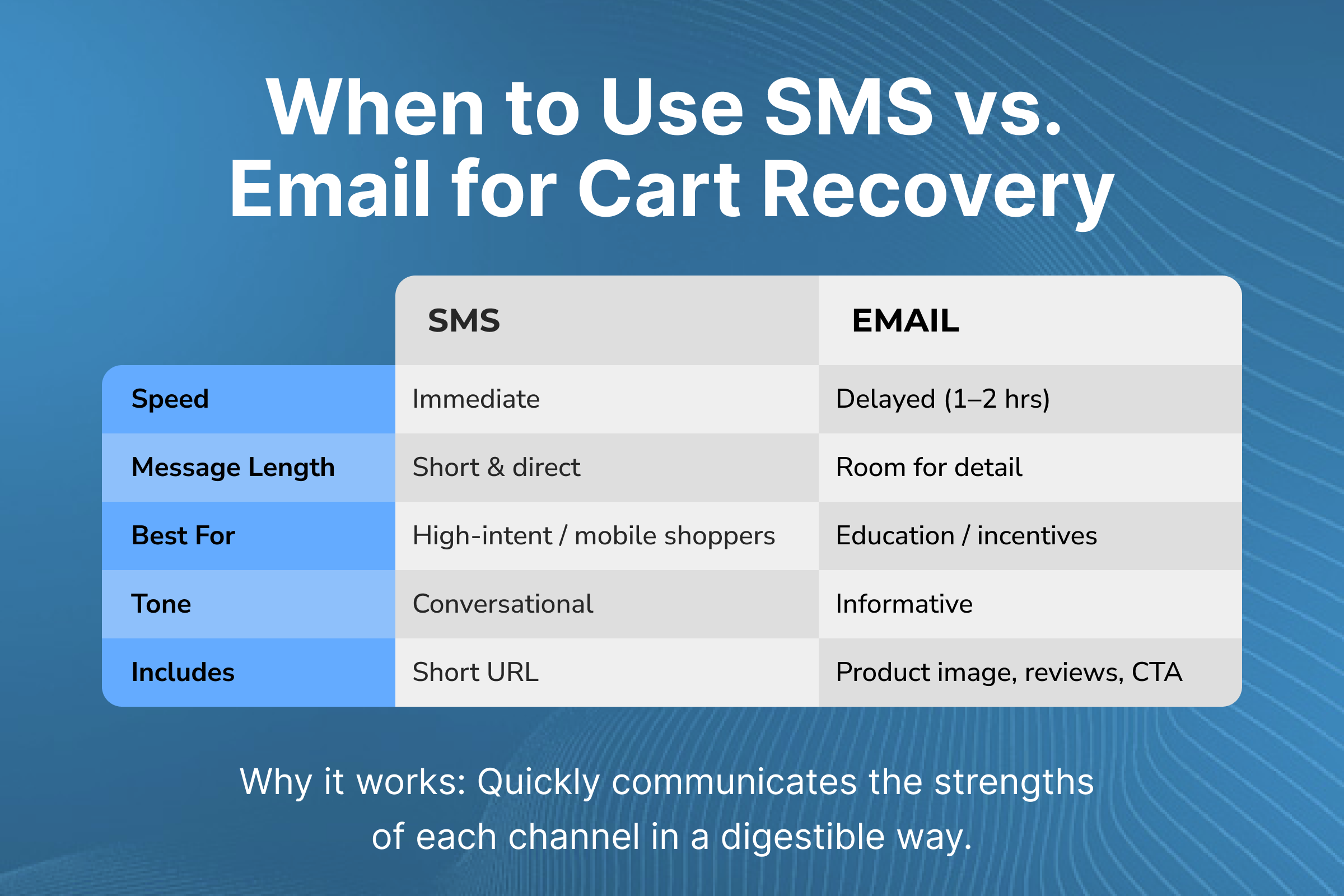
Email vs. SMS for Abandoned Carts: When to Use Each (and How to Combine Them)
Cart abandonment is a familiar challenge for ecommerce brands. But recovering those sales takes more than a reminder. It takes the right timing and the right channel.
Both email and SMS can be effective, and often work best together.The key is knowing when to use each, how to combine them, and how to keep your messages helpful, not spammy.
This guide breaks down the strengths of each channel and offers a framework to create smarter, more effective SMS + email flows for abandoned cart recovery.
Why Cart Abandonment Happens (and Why Timing Is Everything)
Before choosing your channel, it helps to understand why shoppers abandon carts in the first place. It’s not always about price.
Common reasons include:
- Unexpected shipping costs
- Distractions or interruptions mid-checkout
- Uncertainty about returns or product details
- Comparing options or saving items for later
What matters is that your follow-up reaches them while the intent is still fresh. This is where speed, tone, and timing come into play, and where Shopify automation helps you move quickly, without doing it all manually.
When to Use Email for Cart Recovery
Email is your most flexible and scalable tool for abandoned cart recovery. It’s visual, trackable, and gives you room to explain, reassure, and convert.
Best for:
- Shoppers who are earlier in the funnel
- Longer-form follow-ups (like adding reviews or FAQs)
- Delivering discount codes or bundle offers
- Situations where visuals or product context helps
Tips for conversion optimization via email:
- Send the first reminder within 1–2 hours
- Include the exact item(s) they left behind
- Add social proof (like reviews or “almost sold out” badges)
- Keep your CTA prominent and clean
You can also build multi-step flows, starting with a gentle reminder, then adding an incentive 24–48 hours later.
When to Use SMS for Cart Recovery
SMS works best when you need to be immediate, clear, and hard to ignore. With open rates around 98%, it’s an ideal tool for quick nudges.
Best for:
- High-intent shoppers who made it to checkout
- Short windows (like flash sales or limited stock)
- Mobile-heavy audiences
- Brands with a strong conversational tone
Best practices for SMS abandoned cart recovery:
- Get consent, always. Only message opted-in users.
- Keep it short, friendly, and useful
- Include a direct link back to their cart
- Avoid over-messaging or sending multiple texts too quickly
SMS shines in the first few hours after abandonment. It’s also more personal, making it ideal for brands with a casual or community-driven tone.
The Real Power Move? Combine Both Channels
Email and SMS don’t need to compete. In fact, the most effective cart recovery strategies use both, layered smartly based on behavior and timing.
Start with SMS, follow with email
Send a quick SMS reminder shortly after abandonment. If the cart isn’t recovered within a few hours, trigger a follow-up email with more detail, support info, or a discount.
Use behavior to control the flow
If someone clicks the SMS and still doesn’t convert, your email platform can detect that and adjust the messaging, or suppress a second reminder to avoid fatigue.
Match the tone to the channel
An example SMS might be:
“Hey! You left something in your cart. Still thinking it over? Tap here to finish up.”
Your email might say:
“Not quite ready to check out? Here’s what you left behind, plus a few reasons customers love it.”
Together, they create a seamless experience across touchpoints.
Don’t Overdo It. Respect the Channel.
Blasting both email and SMS at once is a fast way to burn trust. Make sure your flows include:
- Delays between sends
- Conditional splits based on activity (e.g. “did they open the SMS?”)
- Smart exclusions for people who’ve already purchased or opted out
The goal is to recover the sale without overwhelming the customer. And your tools should make that balance automatic.
What About Segmentation?
Not every customer should get the same cart recovery flow.
Use Shopify data to segment by:
- Order value (only send SMS for higher-ticket carts)
- Product type (only trigger for certain categories)
- Customer type (first-time vs returning)
- Device or location (mobile vs desktop shoppers)
Even one or two filters can improve results without adding complexity.
If you’re unsure how to set this up, it may be worth looking at a team that specializes in email automation strategy, like In-box, which works with ecommerce brands to build systems that scale without extra work.
Final Thoughts
There’s no single “best” channel for abandoned cart recovery. It depends on your audience, your offer, and your tone.
Use email when you need room to explain. Use SMS when timing is critical. Use both when you want to recover more revenue without adding more noise.
And if you want to dive deeper into CRM and retention strategies, the In-box Insights hub has practical examples from brands doing it well.
Smart cart recovery doesn’t need to be complicated. It just needs to be thoughtful.
Ready to start your free trial?
Increase your revenue by re-engaging undecided shoppers with help from our expert live agents.

